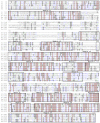Medaka tert produces multiple variants with differential expression during differentiation in vitro and in vivo
- PMID: 21547060
- PMCID: PMC3088285
- DOI: 10.7150/ijbs.7.426
Medaka tert produces multiple variants with differential expression during differentiation in vitro and in vivo
Abstract
Embryonic stem (ES) cells have immortality for self-renewal and pluripotency. Differentiated human cells undergo replicative senescence. In human, the telomerase reverse transcriptase (Tert), namely the catalytic subunit of telomerase, exhibits differential expression to regulate telomerase activity governing cellular immortality or senescence, and telomerase activity or tert expression is a routine marker of pluripotent ES cells. Here we have identified the medaka tert gene and determined its expression and telomerase activity in vivo and in vitro. We found that the medaka tert locus produces five variants called terta to terte encoding isoforms TertA to TertE. The longest TertA consists of 1090 amino acid residues and displays a maximum of 34% identity to the human TERT and all the signature motifs of the Tert family. TertB to TertE are novel isoforms and have considerable truncation due to alternative splicing. The terta RNA is ubiquitous in embryos, adult tissues and cell lines, and accompanies ubiquitous telomerase activity in vivo and in vitro as revealed by TRAP assays. The tertb RNA was restricted to the testis, absent in embryos before gastrulation and barely detectable in various cell lines The tertc transcript was absent in undifferentiated ES cells but became evident upon ES cell differentiation, in vivo it was barely detectable in early embryos and became evident when embryogenesis proceeds. Therefore, ubiquitous terta expression correlates with ubiquitous telomerase activity in medaka, and expression of other tert variants appears to delineate cell differentiation in vitro and in vivo.
Keywords: TRAP; medaka; pluripotency; senescence; telomerase; tert.
Conflict of interest statement
Conflict of Interests: The authors have declared that no conflict of interest exists.
Figures






Similar articles
-
Identification of pluripotency genes in the fish medaka.Int J Biol Sci. 2011 Apr 15;7(4):440-51. doi: 10.7150/ijbs.7.440. Int J Biol Sci. 2011. PMID: 21547061 Free PMC article.
-
Tert expression and telomerase activity in gonads and somatic cells of the Japanese medaka (Oryzias latipes).Dev Growth Differ. 2008 Mar;50(3):131-41. doi: 10.1111/j.1440-169X.2008.00986.x. Epub 2008 Feb 27. Dev Growth Differ. 2008. PMID: 18312429
-
Hypoxia induces telomerase reverse transcriptase (TERT) gene expression in non-tumor fish tissues in vivo: the marine medaka (Oryzias melastigma) model.BMC Mol Biol. 2006 Sep 11;7:27. doi: 10.1186/1471-2199-7-27. BMC Mol Biol. 2006. PMID: 16961934 Free PMC article.
-
The role of telomeres and telomerase reverse transcriptase isoforms in pluripotency induction and maintenance.RNA Biol. 2016 Aug 2;13(8):707-19. doi: 10.1080/15476286.2015.1134413. Epub 2016 Jan 19. RNA Biol. 2016. PMID: 26786236 Free PMC article. Review.
-
Feedback regulation of telomerase reverse transcriptase: new insight into the evolving field of telomerase in cancer.Cell Signal. 2013 Dec;25(12):2462-8. doi: 10.1016/j.cellsig.2013.08.009. Epub 2013 Aug 29. Cell Signal. 2013. PMID: 23993966 Review.
Cited by
-
Fish stem cell cultures.Int J Biol Sci. 2011 Apr 13;7(4):392-402. doi: 10.7150/ijbs.7.392. Int J Biol Sci. 2011. PMID: 21547056 Free PMC article. Review.
-
Telomerase regulation.Mutat Res. 2012 Feb 1;730(1-2):20-7. doi: 10.1016/j.mrfmmm.2011.10.003. Epub 2011 Oct 18. Mutat Res. 2012. PMID: 22032831 Free PMC article. Review.
-
Defining the Pluripotent Marker Genes for Identification of Teleost Fish Cell Pluripotency During Reprogramming.Front Genet. 2022 Feb 11;13:819682. doi: 10.3389/fgene.2022.819682. eCollection 2022. Front Genet. 2022. PMID: 35222539 Free PMC article.
-
Identification of pluripotency genes in the fish medaka.Int J Biol Sci. 2011 Apr 15;7(4):440-51. doi: 10.7150/ijbs.7.440. Int J Biol Sci. 2011. PMID: 21547061 Free PMC article.
-
Impaired telomerase activity hinders proliferation and in vitro transformation of Penaeus monodon lymphoid cells.Cytotechnology. 2016 Aug;68(4):1301-14. doi: 10.1007/s10616-015-9890-9. Epub 2015 Jun 18. Cytotechnology. 2016. PMID: 26084784 Free PMC article.
References
-
- Hayflick L, Moorhead PS. The serial cultivation of human diploid cell strains. Exp Cell Res. 1961;25:585–621. - PubMed
-
- Campisi J. Senescent cells, tumor suppression, and organismal aging: good citizens, bad neighbors. Cell. 2005;120:513–522. - PubMed
-
- Harley CB, Futcher AB, Greider CW. Telomeres shorten during ageing of human fibroblasts. Nature. 1990;345:458–460. - PubMed
-
- Zakian VA. Telomeres: beginning to understand the end. Science. 1995;270:1601–1607. - PubMed
Publication types
MeSH terms
Substances
LinkOut - more resources
Full Text Sources

